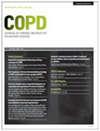基于氟替卡松与基于布地奈德的三联治疗COPD:真实世界的比较有效性和安全性
IF 2.2
4区 医学
Q3 RESPIRATORY SYSTEM
COPD: Journal of Chronic Obstructive Pulmonary Disease
Pub Date : 2022-04-06
DOI:10.1080/15412555.2022.2035705
引用次数: 3
摘要
慢性阻塞性肺疾病(COPD)的三联疗法被推荐用于一些患者,但吸入皮质类固醇(ICS)的有效性和安全性可能存在差异。我们采用观察性研究方法,比较了布地奈德和氟替卡松三联治疗在两种吸入器中的加重发生率、死亡率和重症肺炎发生率。我们从英国CPRD数据库中确定了一组COPD患者,2002-2018年期间使用两个吸入器进行三联治疗的新使用者,年龄在50岁或以上,并随访了一年。使用Cox回归模型估计病情加重、全因死亡和肺炎的风险比(HR),并对开始治疗的倾向评分进行精细分层加权。该队列包括29,716名以氟替卡松为基础的三联疗法新使用者和9,646名以布地奈德为基础的三联疗法新使用者。与基于氟替卡松的三联疗法相比,布地奈德为基础的首次中度或重度加重的HR为0.98 (95% CI: 0.94-1.03),而严重加重的HR为0.97 (95% CI: 0.87-1.07)。布地奈德为基础的治疗在既往无加重的患者中全因死亡发生率较低(HR 0.80;95% ci: 0.66-0.98)。布地奈德治疗重症肺炎的HR为0.84 (95% CI: 0.75-0.95)。在现实世界的慢性阻塞性肺病治疗临床环境中,布地奈德三联治疗在减少急性加重方面通常与氟替卡松三联治疗一样有效。然而,以布地奈德为基础的三联治疗与较低的严重肺炎发生率相关,也可能与全因死亡相关,特别是在先前没有加重的患者中,不推荐三联治疗。本文的补充数据可在https://doi.org/10.1080/15412555.2022.2035705上在线获得。本文章由计算机程序翻译,如有差异,请以英文原文为准。
Fluticasone-Based versus Budesonide-Based Triple Therapies in COPD: Real-World Comparative Effectiveness and Safety
Abstract Triple therapy for chronic obstructive pulmonary disease (COPD) is recommended for some patients, but the inhaled corticosteroids (ICS) may differ in effectiveness and safety. We compared budesonide-based and fluticasone-based triple therapy given in two inhalers on the incidence of exacerbation, mortality and severe pneumonia, using an observational study approach. We identified a cohort of patients with COPD, new users of triple therapy given in two inhalers during 2002–2018, age 50 or older, from the UK’s CPRD database, and followed for one year. The hazard ratio (HR) of exacerbation, all-cause death and pneumonia was estimated using the Cox regression model, weighted by fine stratification of the propensity score of treatment initiation. The cohort included 29,716 new users of fluticasone-based triple therapy and 9,646 of budesonide-based. The HR of a first moderate or severe exacerbation with budesonide-based triple therapy was 0.98 (95% CI: 0.94–1.03), relative to fluticasone-based, while for a severe exacerbation it was 0.97 (95% CI: 0.87–1.07). The incidence of all-cause death was lower with budesonide-based therapy among patients with no prior exacerbations (HR 0.80; 95% CI: 0.66–0.98). The HR of severe pneumonia with budesonide-based therapy was 0.84 (95% CI: 0.75–0.95). In a real-world clinical setting of COPD treatment, budesonide-based triple therapy given in two inhalers was generally as effective at reducing exacerbations as fluticasone-based triple therapy. However, the budesonide-based triple therapy was associated with a lower incidence of severe pneumonia and possibly also of all-cause death, especially among patients with no prior exacerbations for whom triple therapy is not recommended. Supplemental data for this article is available online at https://doi.org/10.1080/15412555.2022.2035705 .
求助全文
通过发布文献求助,成功后即可免费获取论文全文。
去求助
来源期刊

COPD: Journal of Chronic Obstructive Pulmonary Disease
RESPIRATORY SYSTEM-
CiteScore
4.40
自引率
0.00%
发文量
38
审稿时长
6-12 weeks
期刊介绍:
From pathophysiology and cell biology to pharmacology and psychosocial impact, COPD: Journal Of Chronic Obstructive Pulmonary Disease publishes a wide range of original research, reviews, case studies, and conference proceedings to promote advances in the pathophysiology, diagnosis, management, and control of lung and airway disease and inflammation - providing a unique forum for the discussion, design, and evaluation of more efficient and effective strategies in patient care.
 求助内容:
求助内容: 应助结果提醒方式:
应助结果提醒方式:


